Home page
» HEALTHCARE
» Folk medicine
» Healing plants
Healing plantsLILY (white lily, Lilium candidum). 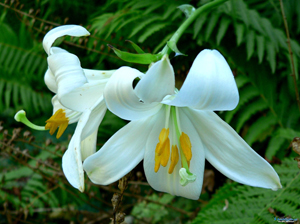 Spread throughout the Mediterranean region since ancient times. In Azerbaijan it is cultivated as ornamental plants in the house. Middle Ages famous pharmaceutics Mohammed Momin notes in his work Tohfatul-mominin (year 1669) that lily shoots or flower mixed with vinegar or barley flour is useful at treatment of inflammation of tumors in tubers. Lily fragrance creates a sense of passion in women. The liquid of lily shoots baked in a copper bowl when mixed with 1/5 parts of vinegar and honey, such preparation cleans the sore and is close to the iris oil for its effect. This medicine can be used at curing of womb and neuralgia. In such cases, as well as compress with the lily oil is useful. Compress with leaves of lily, as well as taken seeds are useful at bites of parasites. At folk medicine oil of lily is used in the treatment of burn wounds and is used a drops for treating ear pain, it is also used in perfumery. The liquid made from plant and its shoot is used as sore curing matter. After nectar made of its flower is kept in olive oil has a good effect in sore and burns. It was found at the result of experimental studies that the plant has a diuretic effect. 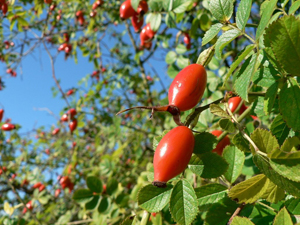 From 300 species of this sort 42 species of dog-rose are found, from which 36 is wild. 2 sorts is more important for the industry. These are brown and fold dog rose. For healing properties dog rose occupied deserved place in medicine from ancient times. As its composition is rich with biologically active substances, C, A, F, P vitamins, pectin, microelements, dog-rose (hips) is able to fight various diseases in organism. LILAC (Medicinal lilac, Jasminum officinale). 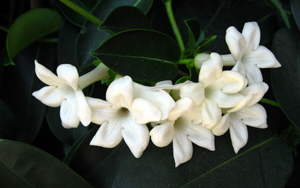 This wild bush with fragrant flowers is to be found in the mountains of Lankaran at wild conditions. Mohammed Momin shows that to smell this flower is helpful in headaches and brain strengthening. When using the extract of lilac it helps in headaches. The compress of lilac flowers cleans the skin spots and makes the face reddish. Solution from lilac leaves used in the outside strengthens the erection. Lilac extract colors the hair with open color, or rather, they become colorless. If it is taken much it may cause headache. In this case, violet, gold roses and vinegar balance it. Leaves of big lilac are used in skin diseases, mouth sores and in dental pain. Fresh juice of leaves softens callosity. Liquid from flowers is used for eye washing, and extract of flowers are used in the cosmetics. In modem scientific medicine use of lilac is not so widespread. From lilac flowers, ketone, jasmon and indol lilac oils are made. It is used in perfumery and cosmetics. VAKHTSIZOTU; ITBOGAN; PRIMROSE (vakhtsizotu magnificent, Colchicum speciosum). 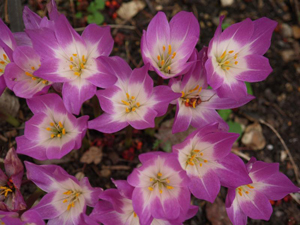 It is medicinal plant. As there is a possibility of poisoning it is not recommended to take without consulting doctor. According to Mohammed Momin the bulb of vakhtsizotu keeps its therapeutic effect for 7 years. They have phlegm removing effect, takes the pus, and good at jaundice and spleen disease. The compress of bulb of vakhtsizotu and aloe was tested as good at sciatic (nerve inflammation) disease. Juice of vakhtsizotu or its decoction is good for rheumatism. The decoction of vakhtsizotu mixed with saffron and non-boiled egg is good for bone traumas and oedema as compress. Tampon from decoction of vakhtsizotu and old sheep fat was tested at haemorrhoid. Powder of roots of vakhtsizotu makes sore dry. According to Tohfatul-mominin (1669 years) work, when taken inside it is useful for stomach, liver and convulsion. Ibn Sina writes that vakhtsizotu weakens the stomach. When used externally, it is userful in the diseases like the old (chronic) ulcers, grout, and pain in muscles. Toxic alkoloid kolkhiser in bulb of vakhtsizotu (combination of kolkhisin and kolkhamine), eliminates mitosis in tissue cells of 1% solution and delas the development of cancer cells. The poison of kolkhamin is little less and it is used in treatment of 1 and 2 degree skin cancer It roots and seeds are used in treatment of chronically leucosis as liquid and extract. RUE (Ordinary rue, Peganum harmala). 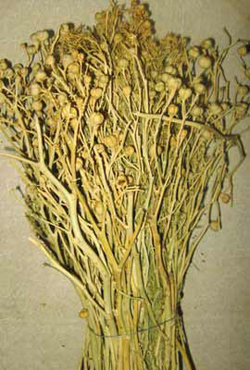 Rue grows in the semi-desert regions of Azerbaijan. Without consulting the doctor it can not be taken - excess dosage may cause the danger of poisoning. According to pharmacists Haji Suleyman Iravani living in the XVII century rue can be stored for 4 years, after this period it loses its therapeutic nature. Grass and seeds of rue has diuretic effect, and increasing sexual potential. It also has phlegm removing effect and useful in colds. Moreover rue liquid strengthens the memory, useful in neuralgia and headaches. It is best in asthma and wet cough. In order to remove the chronic headache 340 grams of rue seeds should be boiled in 1 liter of wine or grape juice so that it turns to dense juice form. Then, to drink it in 60 grams doses during 3 days and it will eliminate the headache. In dry form its dosage reaches up to 9 grams. It may be replaced by wild caraway. Alkaloid obtained from seeds and roots of rue is used in cerebral diseases, especially at Parkinson, as well as during complication of epidemic and lethargic encephalitis. Peganine hydrochloride is allowed for usage in muscle weakness (myopathy and myasthenia) for treatment. PINE (Pinus spp.). 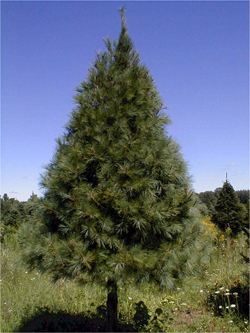 According to Mohammed Momin the bark of pine-tree root has rumpling and drying effect. If 9 grams of this medicine is taken, it is good at diarrhea, and if rubbed on skin it helps to cure not a deep wounds and abrasions. The powder form of root is useful at hot water burns, bruises or hurts. Decoction of coniferous is used at diseases of the kidney and lungs. Ointment of crashed coniferous plant is good with bilberry oil at skin ulcers, and with red vitriol is at purulent wounds. At liver tumors and chronic diseases 4.5 g of pine tree honey is recommended to drink with water. Taking bath with decoction of coniferous is useful at womb and rectum diseases. It also cleans dirt, sweat and makes trunk refreshed. At dental pain to rinse the mouth with coniferous decoction and vinegar gives successful results. To have inhalation with the steam of coniferous helps for abortion and stimulates the beginning of the menstrual period. Smoke of coniferous helps at fell of eye-lashes and brows and at tearing of eyes and at weak eyesight. Decoction of pine tree is good treatment against cough. From its coniferous leaves preparations against kidney disease and pine tree extract are made for a bath. Coniferous carotene paste is used in the treatment of wounds. When the pine tree trunk is cut the dense resin solution named turpentine” in ether oil is received. This resin is used as sore healing meansr. SHAHTARA (Medicines shahtara, Fumaria officinalis). 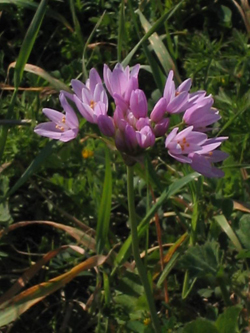 This annual plant is widely spread in Azerbaijan. Chemist Yusuf Ibn Ismail Khoyi wrote in 1311 that its leaves are more effective than other parts. Shahtara has cholagogic effect, it strengthens the trunk, it is diuretic, blood-purifying and appetite exciting. A mixture of shahtara with vinegar prevents gall vomiting. Fresh juice of shahtara with tamarind fruits cleans bowels and stomach. When used externally it removes herpes. Shahtara extract is dropped on eye as antiseptic. If it is mixed with resin of coniferous trees it can be used to prevent the formation of sty. When to rinse the mouth with decoction of shahtara it is useful in tongue inflammation and it is good for strengthening of palates. Bulgarian scientists advise to prepare extract of shahtara: extract of 2-3 teaspoon of shahtara grass is poured in 1 glass of water and the mixture is kept for 3-4 hours that the infusion is ready. Then it is filtered, 1 table spoon should be taken 3-5 times a day. Also, the plant mixture with shahtara herb inside is used, too. Mixing of shahtara juice with sugar (both is taken on the same amount) and each day is recommended to take 2-5 table spoons. Scientists have determined that shahtara has the spasmodic influence and tones up the muscles of digestive tract, urinary and gall ways. In addition, it reduces blood pressure, has positive inotropic and chronotropic effect on heart, stimulates the breathing, prevents the spasm of muscle and reduces effect of cerotine. Medicines shahtara and some preparations from it is used at gall bladder colics, choliethiasis, migraine and chronic constipation and haemorrhoids. WILLOW (Salix spp.). 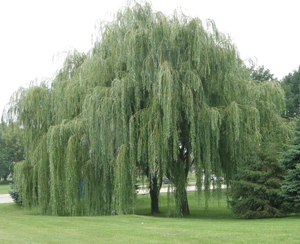 14 species of willow are wide-spread n Azerbaijan. Mohammad Momin wrote that the decoction of willow flowers and leaves has choleretic effect and prevents fast heart beat. In addition, willow decoction is useful at fever, chills, in various diseases and headache. When to drink willow extract, it has choleretic and diuretic effect. Therefore, the extract is useful against blocking of biliary tracts and at jaundice. As a means against heating and fever it removes trembling and used at rheumatism and gout. Willow decoction is used against the poisoning from scorpions and from toxic spices. Willow decoction is good to drink with rose water and sugar at 65 grams of dosage. Fruits of willow are eaten at bloody diarrhea and dysentery. To take bath in decoction of willow leaves and branches has a good effect at small sores and ulcers on trunk. At modern Azerbaijani folk medicine male flowers of goat willow (pishpisha) are used as soothing, fever reducing , anti-malaria means. Despite of presence of salicylic compounds in bark of willow (the content close to aspirin) it has blood detaining quality. The aqueous and spirit extract from willow bark antivirus effect and prevents the influenza disease. At cold willow bark is prescribed as sweat expelling mean. The decoction made of goat willow (pishpishas) male flowers is good for heart arrhythmia and tachycardia and soothing the headache at neuralgia. CYPRESS (Evergreen cypress, Cupressus sempervirens). 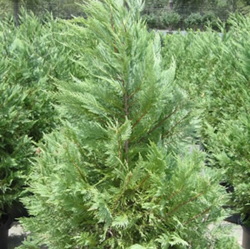 This evergreen tree since ancient times is grown in Azerbaijan. Mohammed Hossein Khan (XVIII century) writes: 9 grams of cypress tree coniferous leaves when taken inside together with 2.25 grams of grinded balsamic myrrh it is good for urinary bladder, helps in urinary stagnation. Washed coniferous leaves ashes are good for healing burns, and non-washed on newly formed sore. Juice of green fruit of cypress is dropped on sore inside the nose. In addition, when used leaves of cypress externally the tired hands/legs get strengthened, it prevents bleeding, dries the wounds, and sucks the tumors. The grinded leaves of cypress are mixed with barley flour and helps in anemia and burns. If there will be sores in palates and at tooth pains the decoction of leaves and nuts is to be used for rinsing of mouth. At bite of toxic parasites the decoction of nuts should be used for inhalation. The ointment of cypress nuts and its honey if taken inside it suppresses the cough and strengthens stomach. In Azerbaijani folk medicine cypress nuts in the form of decoction is used against diarrhea and hemorrhoids. PAMBIQKOLU (Cotton bush) (curly pambıqkolu; Gossypium hirsutum). 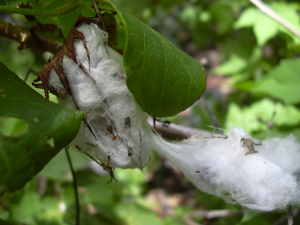 According to Haji Suleyman Iravani, decoction of 30 grams of flowers of pambıqkolu eliminates heartbeat, nervousness (hysteria) cases in women, concerns. The bandage made of mix of grinded flowers and leaves of burnt cotton sucks the tumors, eliminates itching and useful at burns. Juice of leaves prevents diarrhea, in particular, if 85 grams of this juice is drunk with apple decoction it has stringer Compress made of mix of grinded cotton bush leaves and rose oil has a good effect at gout. Cotton clothing strengthens the trunk and used at Parkinson\'s and paralysis diseases. Bath from cotton leaves’ decoction calms the nerves and eliminates the cases of stress at women. It is good to have inhalation with steam of cotton leaves. Ash of cotton helps to prevent bleeding. Mixture of cotton seeds with cinnamon increases sexual desire, and eliminates spasms. Pambıqkolu is used for medical preparations - furasimin, furasil, furadonin and others. Extract of root is included in gossypol preparation and has blood stopping effect. OAK (Quercus spp.) 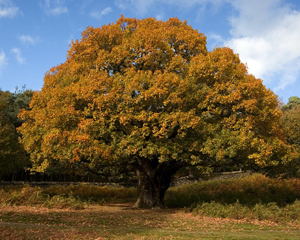 Oak has 12 species in Azerbaijan. In 1311 Yusuf Ibn Ismail Khoyi wrote that the oak nut has astringent effect and it is used against diarrhea and bleeding and bloody phlegm. At urination, bowel ulcers, heartbeat problems and nausea the oak nuts are useful to eat. The bandage made of flour of nut and pig fat is used at purulent tumors. The author of Jamul-Bagdadi (1311) writes that the ash of oak nut is good against purulent sores at mouth (stomatitis). The lump in the trunk of oak (gall or Turkish oak nuts, in vulgar language - oak cancer) is widely spread in the East as a strong astringent and blood stopping. It is said mazu or mazi. The powder made of lumps is poured in water and used in bowel ulcers and chronic diarrhea. Sometimes they are use for a long time against hemorrhoids as compress after boiling it. In scientific medicine the bark of winter oak is used. The bark of oak is used with 10% decoction and sometimes mixed with aulm and used at stomatitis, gingivitis and other inflammatory processes, in damaged and bleeding palates by rinsing the mouth cavity. Oak root decoction is used in gastrointestinal diseases as astringent and antiseptic means, as well is used as enema in cases of poisoning from salt of heavy metals and other poisoning. The decoction of root is used at burns, hand and foot sweating. Water extract of nuts have sugar reducing property and helps in light form of diabetes. ROSE (Rosa spp.). 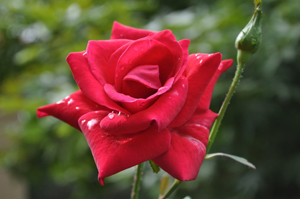 It was widely used in medieval medicine and perfumery. Mohammad Momin writes that to drink rose water is good for heart disease and lungs and refreshes the human trunk. Rose is used at head, eye and ear pains. If the mouth is rinsed with decoction of rose petals the palates will be strong. The wound covered with bandage of dry petals powder has a healing effect in skin scratching and sores. Compress of rose petals attract metal objects and torn in skin. Decoction of rose seeds is good at diarrhea and blood vomiting. Decoction of seeds and candle prepared from the leaves strengthens womb. Muhammad Yusif Shirvani wrote that in 1712, rose water has a diuretic effect, and it reduces the fever and eliminates the thirst, makes trunk refreshed. In Azerbaijan fresh roses petals are mixed with sugar and “gulband’ is made which is useful in cough, tuberculosis and rheumatism. In modern medical science rose is not applied at a wide range. However, the roses are antiseptic, has been approved to treat heavy wounds. The red rose petals have astringent and corrective action in diarrhea. The oil of rose has a spasmalitic effect and calms the nervous system. HORSETAIL (Equisetum). 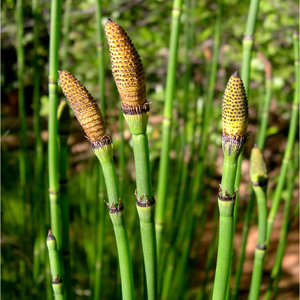 To boil and drink horsetail helps in reducing of stones and salts in urinary ways and in kidneys. In order to reduce the pain of physical bodies horsetail, dill seedlings and nettle should be boiled together and the bath is taken in it and then its water can be drunk. This method of treatment is to be continued for 10-15 days, so then the treatment can be effective, and the patient sleeps comfortably at night. QARAYONJA (Planting qarayonja, medicaqo sativa). 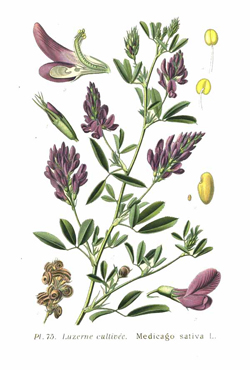 Qarayonja is grown in the irrigation areas of Azerbaijan. Yusuf Ibn Ismail Khoyi (XIII-XIV centuries) wrote that to treat head trembling twice a day a compress of boiled garayonja is to be put on head. If grass and seeds of qarayonja are eaten regularly, it increases the blood of man and makes a man fatty. Compress of garayonja with honey removes cold tumors and mix with vinegar takes the hot tumors. Seeds of garayonja are more useful than other parts. They strengthen the stomach, create sperm and milk, remove the menstrual cycle, are good at cough. In scientific medicine dried and powder garayonja has blood keeping and sore healing effects. Planting garayonja can be used at diabetes, the reduction of thyroid gland functions, and sickle shaped garayonja in pneumonia, diarrhea (stomach problem), and fast heat beats. QARACHOREKOTU (Planting garachorekotu, Nigella sativa). 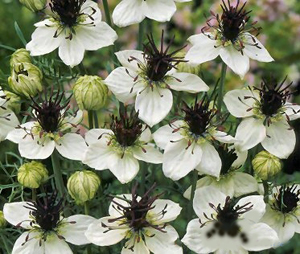 This plant is widely spread in Azerbaijan’s Karabakh, and Kazakh-Borchali zones. Seeds of qarachorekotu are used in medicine since ancient times in Azerbaijani culinary. Yusuf Ibn Ismail Khoyi (1311) writes that the duration of storage of its seeds is 7 years. Inhalation of garachorekotu decoction with steam is good at bites of poisonous insects, colitis, chest pain, cough, vomiting, and heart nausea. Qarachorekotu is bile expelling means, its decoction is useful at lung, gall bladder diseases. If to drink every morning olive oil with decoction of garachorekotu, it will fresh the face. A mixture of decoction of garachorekotu with vinegar removes the helminthes from intestine. Decoction of garachorekotu with honey water can be used against stones in kidneys and urinary bladder. Flower of garachorekotu is used as ointment on haemorrhoids. In folk medicine garachorrkotu seed is used at gas accumulation in intestine, against helminthes and jaundice. In modern medical science garachorekotu removes gases, has mild laxative effect, and removes helminthes. As a result of modern research it was found that the seeds of planting qarachorekotu prevent the development of microbes. The timochinon made of its seeds has bile expelling and nigelon spasm relieving properties. KANDALASH (Otvari kandalash, Sambucus ebulus). 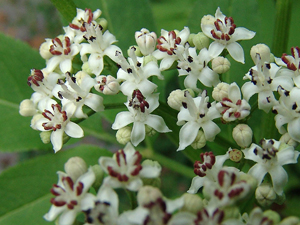 This large perennial grass with creeping roots, almost grows in every corner of Azerbaijan. According to the sources of the Middle Ages, the decoction prepared from the kandalash’s leaves və trunk has phlegm removing effect. The author of the book Tohfatul-momin (1669) notes the following: compress from the juice, trunk or its 8 grams powder is used at fracture of extremities and serious traumas. Decoction of stem is mixed with wine and used at snake bites and rheumatic pains externally, and if drunken it opens blockages of internal organs. At hemorrhoids its leaves is good for bandage. Bath from kandalash decoction is used for tumors in womb. Compress made of kandalash decoction and barley flour is good at burns, tumors, at bite of dog. Kandalash decoction is good at gout together with fat. Usage of kandalash plant decoction externally strengthens the hair and blackens it. At modern Azerbaijani folk medicine the dried leaves of kandalash, its fruit is used for sweating and inflammation. Its juice is a medicine against malaria. Its alcohol extract is used at abdominal pain and leaves at diabetes. Kandalash is a mean as well as soothing and against the depression. It is used as antiseptic against fever, German measles. THYME (thymus spp.). 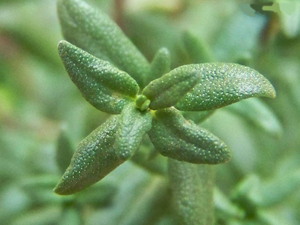 A few species of this plant are spread in Azerbaijan. Haji Suleyman Iravani wrote that thyme improves appetite, helps digestion, and cleans stomach and liver, good for lungs. Flowers of thymes mixed with 9 gr of vinegar and salt is used as bile expelling mean. Decoction of thymes removes spasm in abdomen, makes helminthes removed, helps digestion and is good against vomiting and colitis. Ointment made from thyme and honey is rubbed on site of bite of poisonous insects. Decoction of thymes and fig is drunken at asthma and cough. Juice of thymes with coriander juice is very good at stones in urinary bladder and at blockage of urines. After boiling of sour-sweet blend of thyme, honey, vinegar it is drunk at alash disease. If thyme is eaten with fresh cheese the man gets fatty. If the white spot dropped on eye, it is useful to drop there thyme juice. The decoction of thyme leaves with honey sucks out solid tumors, and it is good in inflammation of nerves. According to scientific medicine thyme is spasmalitic; it calms the central nervous system, and reduces slowly the blood pressure. Thyme is included in the following preparations: pertussol, tusirol, fitodont, armazol, kolinton, broncholind, timipin, pulomonon and others. Timol in ether oil of thumes has antiseptic and disinfectant quality. HENNA (Lawsonia inermis). 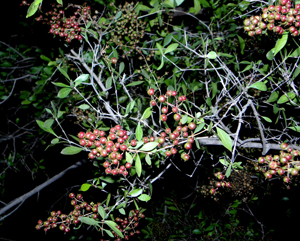 Mohammed Momin wrote in 1669 that the first stage of leprosy the filtered decoction of 315 grams of sugar mixed with 14 grams of henna should be taken every day. If this treatment is continued for a month, it will prevent worsening of leprosy. Henna decoction is used at jaundice, alash, at stones in kidney and urinary bladder, if urine comes with difficulty. It has the ability to abort the child at pregnant women. If taken 9 grams of dried henna on regular basis it will treat colitis. Its extract and decoction is useful at burns and rash of skin. If a child has sore in mouth, the rinsing of mouth with henna should be done. Henna unction is good at severe purulent tumors. If mixed with oil it prevents rash. Henna unction prepared with caster leaves juice is good for skin cracks and rheumatism. According to modern medical science, henna has not been widely used. Experimental research shows that a yellow-red pigment of this plant has a very strong bactericidal effect. The ointment and paste made of henna has a very big effect at eczema. GULAVAR; PEYGAMBARCHICHAYI (Blue gulavar, Centaurea cyanus). 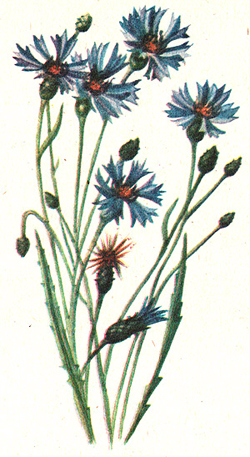 It is annual grass with purple, or blue flowers. It is spread in Azerbaijan in Absheron peninsula, in the Caucasus Mountains and Lankaran. Mohammad Monin writes that the root of gulavar has healing effect for a period of ten years. Extract of its root helps in menstrual cycle and abortion. To drink extract of gulavar root helps against chronic cough and asthma. Essence of root or compress from decoction is used at injury of veins and nerves, as well as fracture of extremities. Compress with the fresh root of gulavar or its dry powder is good at deep wounds. If taken in excess it can cause harm to organs in head. It is balanced by honey. Dose to take inside is 6 grams. According to modern medical science, the main effects of gulavar are to form appetite, tone up the organism and have a diuretic effect. Alcoholic and aqueous essences of its flowers reduce the blood pressure, normalize the heart rhythm. Aqueous essence of blue gulavar is used as diuretic and bile expelling means. Essence of flower has diuretic effect at body swelling of body due to heart and kidney diseases. ALHAGI -DEVETIKANI (Alhagi persarum, A. pseudoalhagi). 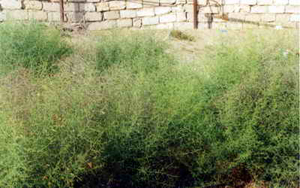 It is spread over the whole territory of Azerbaijan, and grows in the dry places. In the medieval Azerbaijan medicine under the name of “taranjabin solid, hardened juice (scientific language Manna) were widely used. Mohammad Momin writes that manna of alhagi increases the sexual desire, and is good for cough, chest pains, nausea, strong sweating-fever and thirst. Butter with manna is better at blockage of urine. At scientific medicine scientists have determined that alhagi and decoction of its root perishes the microbes and prevents its multiplication and has tart and blood detaining effects. Limpid essence of alhagi and 10% decoction is used as bile expelling and diuretic means. The gray-yellow, sweet, hardened liquid at leaves and branches of the plant in the hottest summer is known under the name of “Manna”. The composition of it consists of kitra, mannit, sugar, citric acid and bitter substances. DAZIOTU (Hole dazıotu, Hypericum perforatum). 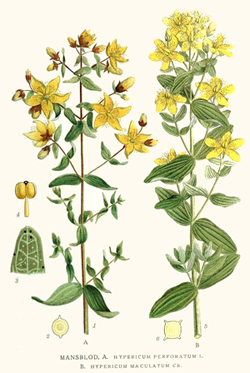 This plant is spread every in Azerbaijan. Mohammad Momin writes that the root of this plant has capacity to keep its effect up to four years. Paste of dazıotu root has helminth expelling effect. Bath of decoction of daziotu is used at vaginal prolapse and has the ability to suck up the womb tumors. The unction of daziotu together with olive oil is best for hemorrhoids. When taken excessively it creates blockage in internal organs. It is prevented by violet oil. Even the urinary bladder can be damaged. Anis is here to help. Dosage of dazıotu is about 12 grams. Half of daziotu is replaced with almonds and 2/3 part with fruit of the juniper. In the modern Azerbaijani folk medicine the upper part of plant from the soil level is prescribed at intestine problems, it is good at stomach, abdomen and duodenum ulcer, at light form diabetis, at cough, liver diseases and as diuretic means. At diseases of the nervous system its aqueous extract is used 3 times a day with 1 spoon as stimulating, toning up and as a sedative. In the scientific medicine daziotu is used as effective bactericide and volatile productions. Essence of dazıotu oil (boiling of grass at sunflower oil) and spirit is used as healing means at 2-3 level burns. Its decoction is used as sweating means in cold and its liquid and spirit essence strengthen the palates, as tarting plant it is used against inflammation and as antiseptic for rinsing the mouth. Basing on catechins of dazioutu the peflavit preparation with vitamin P was developed. Daziotu creates favorable conditions for recovery of dystrophic processes arising from the mucous membrane of stomach. Modern research shows that daziotu helps in the light forms of depression. CHAMOMILES (Ordinary chamomiles, Matricaria chamomilla). 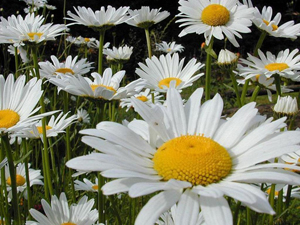 Many kinds of chamomiles are spread in Azerbaijan. The author of the XV century Ali Ibn Hussein Ansari noted that decoction from chamomiles flower has diuretic, lactogen influence (increases milk), it calms the nervous system. When chamomiles flower is chewed it helps against oral wounds. Decoction of flowers of chamomiles is bile expelling, removes gall stones and has a positive effect at inflammation of large intestine and other gastrointestinal diseases. Rubbing of chamomiles flower oil takes cold tumors and cures ulcers. In addition, decoction of chamomiles flower is very useful at fever, cold and shiver. This decoction is good at deafness, back pain, rheumatism. Modern medical research shows that the composition of chamomiles flower contains inflammatory and spasmalitic (spasm taking) matter called chamazulene. Pharmacy chamomiles flowers and decoction is drunken as spasmalitic matter. Chamomiles flowers are included in herbal collection as depressant. Enema of liquid decoction is good at flatulence, gastritis, enteritis and others. MADDER; QIZILBOYA (Georgian qızılboya, Rubia Iberica). 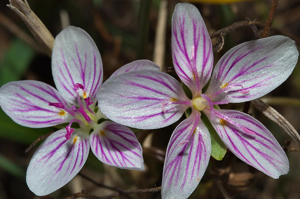 It is spread in lowland and the mountainous regions of Azerbaijan. According to Haji Suleyman Iravani (XVII century), the decoction from root of madder has bile expelling, diuretic effect, helps in the formation of period and helps in lactation in feeding mothers and strengthens the stomach and has abortive effect. Mixture of madder decoction with honey helps in sciatica disease (inflammation of nerve), rheumatic pains, jaundice, and general fatigue. Decoction of madder root is good at liver, gall bladder and alash diseases together with a drink (made of vinegar, honey and sugar). In scientific medicine dust of roots of madder, its decoction and dry extract forms of pills are used at availability of stones in gall and kidneys. Madder preparations remove phosphorus acid and salts from organism, as well as takes active part in melting of the oxalates, phosphates and ureates. BALLIYONJA; KHASHANBUL (Medicines balliyonja, Melilotus officinalis). 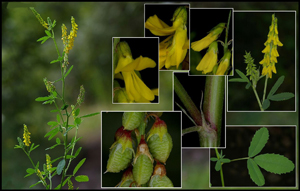 It\'s a two-year herb, which is spread in all Azerbaijan. According to Haji Suleyman Iravani (XVIII century), and, if used externally balliyonja helps to remove pus and tumors. If taken inside it helps in headache and migraine. The ointment of balliyonja is used at eye tumors, its decoction is used at alash and liver tumors. Essence of balliyonja is used as sedative in ear pains. If mixed with saffron balliyonja is used at body wounds. If its decoction is drinken it helps in asthma as well as melts the stones. Scientific medicine shows that the main feature of balliyonja is to be sedative. It is used externally against furuncles. Coumarin in the content of balliyonja delays the processes in the central nervous system. In patients with leucopenia disease coumarin multiplies the number of leucocytes. Balliyonja herbs are used as a poultice and are used at raw material for preparation of melilot band used for removal of pus from sores. JUNIPER (Juniperus spp.). 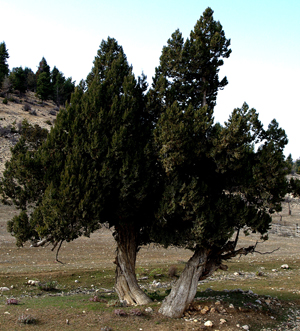 There are 6 wild species of juniper in Azerbaijan. According to the author of the XVII century Mohammed Momin, juniper decoction has a diuretic effect, helps in alash disease and used as anti-helminthes means against some types. The compress made of grinded coniferous leaves is good at ulcers, body numbing, scabies. Unction of grinded fruits with vinegar is good at hair fall. Ointment made of juniper fruits and fig is applied at body freezing. At breathles
sness 30 grams of juniper fruits, 15 grams of butter and 60 grams of honey are recommended to mix. It was determined during the carried out medical experiments that this fruit has antibacterial quality. Spirit solution from ether oil of juniper coniferous leaves or its unction has good effect if rubbed at rheumatism and used as sedative in neuralgia. Juniper tar is included in Vishnevski» sore healing unction. Ether oil has a weak hypertensive effect, i.e. reduces blood pressure. Fruit juice is included in mixture prepared by M.N.Zdrenko. VALERIAN (High valerian, Inula helenium). 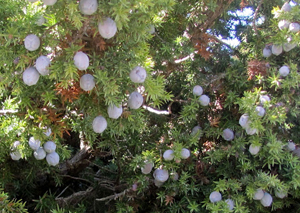 Mohammed Momin notes that the essence of valerian leaves is good against gas collection in intestines, it strengthens stomach, prevents pain in the digestive system. 12 grams of valerian with opopanax is a strong laxative. 4.5 grams of valerian is mixed with 0.05 grams of opopanax and taken inside to remove spasms in the stomach due to cold. Valerian, ravand essence and bitter almond oil are used to prepare drops for nose. These drops clean nose-throat and good at forgetfulness, listlessness and cold. Powdered valerian herb cures external (on the body) wounds. In Azerbaijani folk medicine brewing of valerian flowers (tea) is used as a phlegm removing means. Its root and liquid essence of flower and decoction is used at diseases of gastrointestinal tract and abdominal pain to remove it. Brewing of leaves and flowers is means against alash disease (hidropos, filling of water in body emptiness). Dry root powder is poured on the wounds and its takes out the trophic ulcers, and unction (ointment) is applied at the treatment of furuncles. According to modern medical science, the main treatment features of valerian: anti-inflammatory, phlegm removing and helminthes expelling. It affects the smooth digestive tract muscles as spasmalitic. Decoction of valerian root is used at cough, bronchitis and cold. From root of valerian the allanton preparation is prepared for treatment of gastric ulcer and duodenum. AGIRGARHA; German pellitory (ANASIKLUS) (Kiprikli anasiklus, Anacyclus ciliatus). 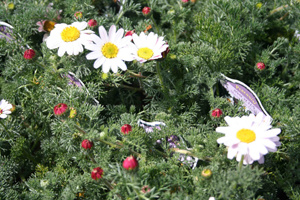 This annual plant grows at the Kur-Araz lowland. According to Yusuf Ibn Ismail Khoyi Anacyclus’s root keeps for 7 years its healing properties. Its decoction increases sexual ability, it is diuretic, and good against cough and inflammation of lungs. The unction prepared of mixture of grinded anacyclus root with aqueous/liquid ammonia is better at burns. This unction also serves to increase male sexual activity. At weak palates and if teeth are loose it is advised to rinse the mouth with anasyclus decoction and vinegar. AJIQIZHY (Medicines ajiqizhy, Nasturtium officinale). 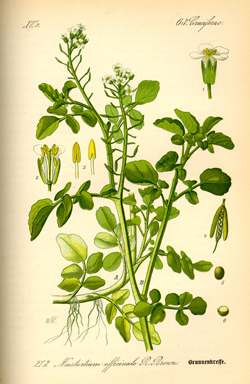 It is perennial herb. Haji Suleyman Iravani (XVIII century) writes that bath of decoction of ajigizhy remove slag from body (waste products) it softens the skin, good at gastro-intestinal tract diseases and rheumatism. Drinking of ajiqizhy decoction make a man refreshed, strengthens internal organs, the brain and heart, and helps to remove menstrual and urine, helminthes from intestines. Mixture of ajiqizhy decoction with vinegar and rose is good at headaches, chest, stomach pain, liver diseases. In addition, to drink ajiqizhy decoction helps to crash and remove stones from urinary bladder. Aziqizhy with the vinegar is good at blood vomiting. When taken in excess it can damage lungs. It is eliminated by coriander. In dry condition the dosage of ajiqizhy is 4.5 g. It is replaced by marza. Oil of ajiqizhy is get from boiling of its juice with sesame oil or the ajiqizhy flower is kept under sun in vegetable oil. If this oil is rubbed it excites the male sexual body and strengthens it, makes hair fragrant and prevents hair fall. In folk medicine aziqizhy is used as helminthes expelling and against scurvy (vitamin C deficiency). It is applied at gall stones and kidney diseases, chronic nephritis, gastritis and at diarrhea. It is used at Ur diseases, eczemas of skin, mucous disease at oral cavity. ADIANT; BALDIRIQARA (Zohratuklu adiant, Adiantum capillus - veneris). 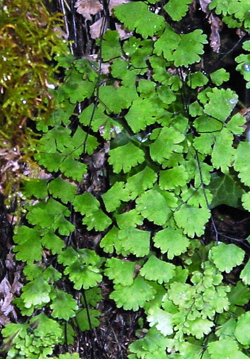 This is a type of ayidosheyi. In Azerbaijan this plant grows in the mountains of Absheron and Lankaran. According to Mohammed Momin the dressing with adiant decoction is good for hair loss, measles and hemorrhoids. If used externally adiant herb is good for prevention of bolding and formation of new hairs. Dry adiant decoction is good for diarrhea. The unction of leaves of this plant is used at treatment of purulent wounds, it is good at bite of insects. To drink its decoction, as well as to mix powder of the leaves with marrow of cow bone and make compress and rub the unction is good for headache. Burnt powder of adiant is used at purulent wounds and the itch. Adiant’s decoction is good at asthma, heartbeat, breast pain, jaundice, stones and post birth bleeding. MALLOW (Malva). 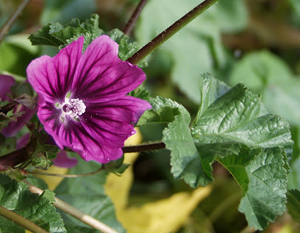 It is very good for the stomach-intestines. In particular, to squeeze and to eat as grass to fry and eat with yoghurt is very useful. Mallow softens the intestines and has helminthes expelling capability, also its improve eyesight, strengthens bottom of teeth. It has good effect at strengthening of bones of neck, head, back, arm, leg of weak born children. It helps at strong cough, abdominal pain, and joint pains. EVELIK (Rumex). 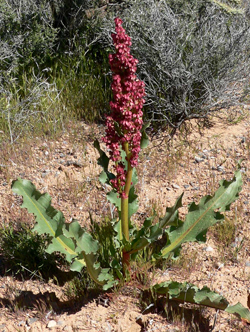 It is perennial, bare grass plants. There are several types of it. With the help of brewery of surface part of ordinary evelik is used at internal bleeding skin diseases as wet dressing, urinary blockages, bad tumors, as bile expelling drug, as well as at treating of fungi diseases at skin, at treatment of purulent furuncles, and from green part juice at fever, scurvy, scabies, rheumatism and bad property cancer. Vitamin elixir is made from its leaves. The fresh leaves and brewery is used at scurvy, strengthening of loosened teeth bottom, at treatment of hardly healing severe purulent sores, its juice used as antiseptic at poisoning. The extract from its fruits had tart, bleeding stopping mean. MINT (Mentha). 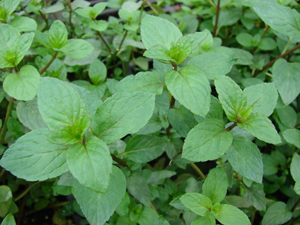 This sort has 25 species distributed in the world flora. These can be found in the Earth\'s temperate climate zone. Thus, there are in Caucasus 8, as well as the 4 species in Azerbaijan. Water mint, long leaved mint, pepper-mint, pulqar mint. The wild-type of mint is called mint mint . In folk medicine pepper mint is used more. This plant has sedative, bile expelling effect, used at treatment of heart pain, rheumatism, cholera and others. Mint is used to remove bad smell from mouth. Other than those specified, mint is used in hemorrhoids, severe headaches, by putting fresh laves on pain site, at nausea, vomiting, rickets, jaundice and others diseases. Extract from leaves and its tea is used for increasing of the stomach acidity, prevention of gall bladder pains. From its ether oil disinfectant, refreshing medicinal tea, flavored water, juice and so on are prepared. It brewing is used to treat diseases of kidneys, joints, the cause of urinary salt, lime at patients, gastro-intestinal, chest pains, it helps to regulate blood circulation. At insomnia during 10-15 days (if you have a good treatment) before going to slip it is advised to have mint boiled and have bath in its water
|
